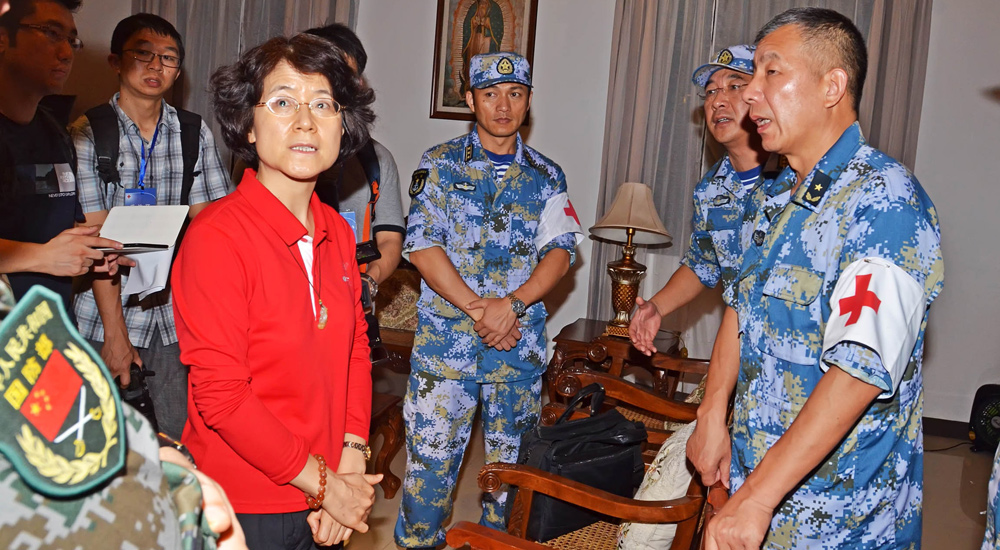
FACE OF CHINA’S SOFT POWER Chinese Ambassador to the Philippines Ma Keqing joins Rear Adm. Shen Hao and others on a visit to Remedios Trinidad Romualdez Hospital in Tacloban City. ANDREW TADALAN
TACLOBAN CITY—The Peace Ark, one of China’s biggest and most modern floating hospitals, began admitting injured survivors of Supertyphoon “Yolanda” for medical treatment on Monday amid a fleet of international humanitarian missions to devastated areas in the Visayas.
“This is an added boost because the Peace Ark is even bigger than our regional hospital in terms of capacity with very experienced doctors and medical staff from China,” said Leyte Rep. Ferdinand Martin Romualdez.
The Philippines and China have been at odds with overlapping territorial claims in the West Philippine Sea (South China Sea).
The 300-bed Peace Ark, the first 10,000-ton-class hospital ship in the world, arrived at the Leyte Gulf before dusk on Sunday. Chinese officials led by Ambassador Ma Keqing met with Romualdez to present the medical services of the ship.
China has yet to join the Multinational Coordinating Council (MNCC), an assembly of the Armed Forces of the Philippines and the militaries of 15 other countries working on the ground to help in the relief and rehabilitation efforts of a clearly overwhelmed Philippine government.
The foreign militaries taking part in the MNCC are Australia, the United States, Japan, Canada, Malaysia, Indonesia, Brunei, Sweden, Vietnam, South Korea, New Zealand, Spain, Thailand, the United Arab Emirates and Israel.
“We are very fortunate that we have many friends and allies that contributed their military assets to help us in the rescue and relief operations. Without them, we would have some difficulty. You know the limitations of our capabilities,” Armed Forces Chief of Staff Lt. Gen. Emmanuel Bautista told reporters in Manila on Monday.
Told that the Peace Ark had already arrived in Leyte province, Bautista said the MNCC “is open to all foreign militaries … so that we can facilitate the coordination for their smooth operation.”
“They are welcome to join us,” he said, referring to China.
Hospital inspection
A nurse on Peace Ark, China’s hospital ship, treats Flora Anade of Alang-Alang town, Leyte province, who suffered a fracture when Supertyphoon “Yolanda” struck. The ship is anchored on the Leyte Gulf. RAFFY LERMA
Ma, Rear Adm. Shen Hao and Senior Capt. Guan Bo Lin, chief of the People’s Liberation Army’s Navy health department, inspected the compound of the privately owned Remedios Trinidad Romualdez (RTR) Hospital on Calinapawan Street here for the possible setting up of an outpatient clinic to treat typhoon victims.
“We suggested that for the following days, we can receive outpatients here (RTR Hospital), and for those patients who need further treatment like surgery or further examination, we can send them to our hospital and they can get better treatment there,” Shen said through a uniformed female interpreter.
Five wounded Filipinos were among the first to be treated in the hospital ship, the Chinese Embassy said in a statement in Manila. Patients at Eastern Visayas Regional Medical Center are allowed to board the vessel from the Tacloban airport, where they will be airlifted to a helipad at the rear or ferried by a Philippine Navy patrol boat.
Free accommodation
Shen said Filipino doctors and nurses could come on board the floating hospital so they could see “with their own eyes” how it operates.
“And we can offer free accommodation for all doctors and nurses and the patients,” he added.
The Inquirer boarded the ship and observed a nurses’ receiving station to process and admit the patients. Some cabins have three or four beds, while others serve as operating rooms. On white walls hang portraits of Chinese officials.
Romualdez said around 100 doctors were on the ship.
In Manila, Bautista said the foreign militaries would be staying in the storm-ravaged areas only until the situation is deemed “an emergency.” They cannot stay in the Philippines indefinitely, he said.
He said the Department of National Defense was acquiring two more C-130 cargo planes, among the workhorses of the Philippine Air Force (PAF) especially during calamities.
“In terms of strategic lift, the C-130 is very important to us. You saw how they have been used in operations other than war like the rescue and relief operations,” Bautista said.
The PAF has only three C-130s, which had more than a thousand flying hours in the past two weeks since Yolanda whipped Eastern Visayas.
The cargo planes ferried relief and flew out thousands of survivors who wanted to leave behind the misery brought by the storm.—With a report from Nikko Dizon in Manila
RELATED STORIES:
Chinese hospital ship arrives in Leyte
16 foreign armed forces helping PH
China joins int’l relief efforts